This Bull Snake care sheet will help get you familiar with a seriously underrated subspecies. These snakes are big, hardy, and easy to look after…
Last updated on February 1st, 2023 at 09:44 am
Bull Snakes are easy to care for. Getting their husbandry right boils down to focusing on providing the correct enclosure, heat, humidity and food. In this article we’ll look at all of these aspects. We’ll also take a look a look at their temperament, which can be much more docile than their reputation would suggest.
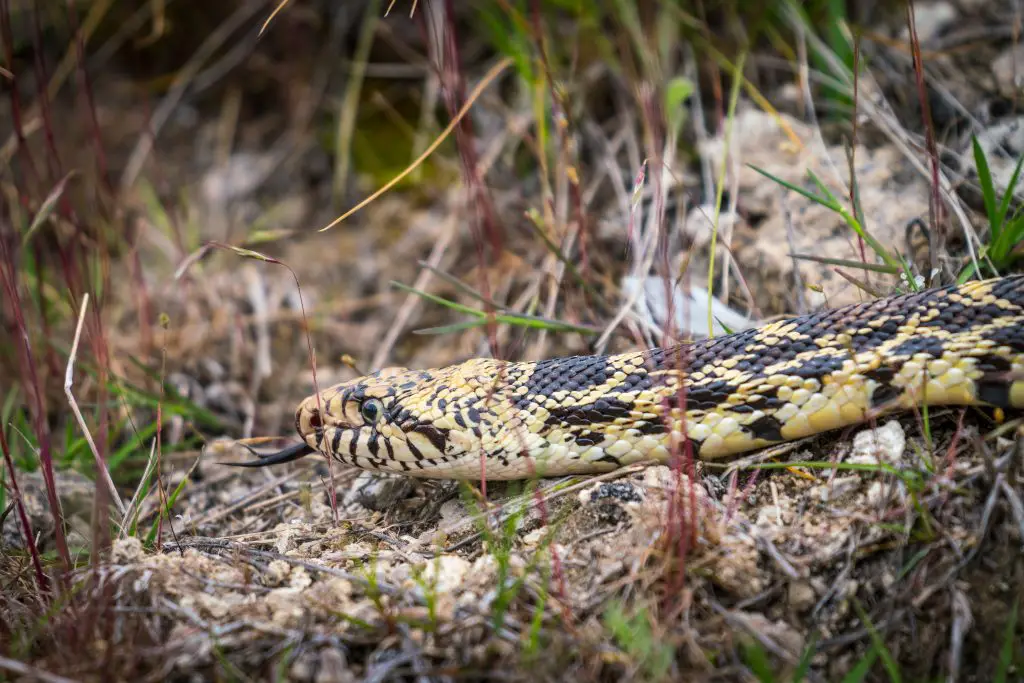
Bull Snake Temperament
As I mention above, Bull Snakes have a reputation for grouchiness. This is overblown in my opinion, although it is true that the babies start out being touchy and defensive.
When you think about it though, this is normal for a species that evolved in the Great Plains region of North America, alongside large ungulates like the Buffalo. Just like Rattlesnakes, they needed to get noticed to avoid being stepped on!
In young or wild Bull Snakes the threat display involves some impressive hissing, striking and tail rattling. If this doesn’t scare you then they resort to striking, though admittedly most of their strikes are with a closed mouth or just miss completely.
The key to turning a defensive baby Bull Snake into a calm adult is regular, respectful handling. My recommendation would be 5 to 10 minutes handling every few days.
Don’t copy some of the “experts” that you see handle them like toys. Swinging them around and trying to control their movements just makes them perceive handling as a stressor. This is not the way to get a calm Bull Snake!
Instead, handle them gently, using slow movements. Make handling time into an opportunity for them to explore rather than a chore and they will become tame before you know it.
In fact, the last Bull Snake I handled was a rescue who had a bad start in life. Nonetheless it was as calm and gentle as a Corn Snake.

Description
The Bull Snake (Pituophis catenifer sayi) is in fact a subspecies of the Gopher Snake (Pituophis catenifer) and as such has the typical chain-link pattern of brown to reddish dorsal blotches on a lighter background.
Due to how huge their natural distribution is, their colour is subject to a lot of variation. Most noticeable is that Bull Snakes from arid areas tend to have much lighter colouration, whereas those from the eastern periphery of their range can have almost black dorsal blotches.
The species also has the typical Pituophis feature of an enlarged rostral (nose) scale which helps with digging. This enlarged nose shield gives their head a pointy appearance.
When it comes to their dorsal scales these are keeled and feel rough, unlike many other popular pet snakes.
If you turn a Bull Snake over, the belly pattern is almost as pretty as the dorsum, being made up of black spots and scares on the outer edges of light ventral scales.
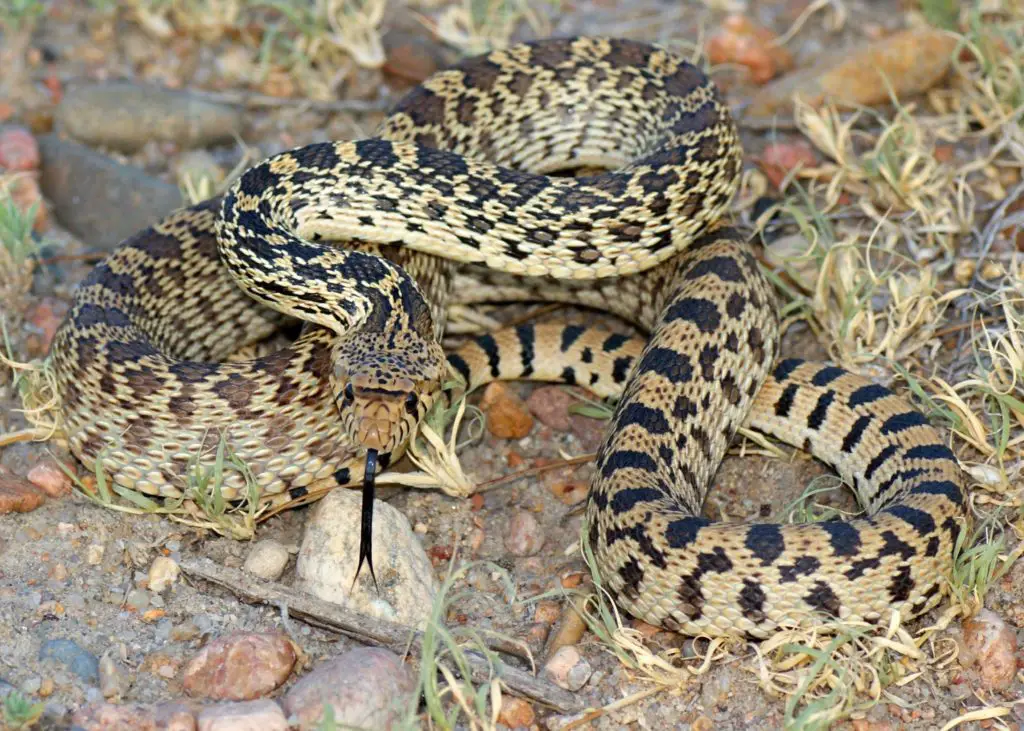
Typical Gopher Snake colour and pattern (above). Bull Snakes are one of several subspecies of this snake which can be difficult to tell apart. Though llisted as a Bull Snake, the animal above may actually be another Gopher Snake subspecies.
With wild specimens you often need to know the locality to know for sure. For a handy range map of where each subspecies lives, I suggest visiting Californiaherps.com

Bull Snakes are generally more boldly marked with larger blotches than other Gopher Snakes. This one is from Texas and is a good example of a reddish Bull Snake popultion.
If you’d like more information on how to distinguish these subspecies, check my article called Bull Snake vs Gopher Snake: What’s the difference?
Bull Snake Size
As far as size goes, this species is one of the largest colubrids in North America. Large adults are solid and heavily built, almost rivalling Indigo Snakes.
Hatchlings usually start out at 12-18 inches (30-45cm) and grow rapidly. Average adults are 4-6ft (1.3-1.8m) in length. Occasionally, weedy individuals under 4ft (1.2m) occur, as do huge 7ft (2.1m) individuals. Officially, the largest specimen recorded was 8’4’’ (2.56m) but the likelihood of seeing one this big is extremely low!
Interestingly, the species doesn’t seem to be sexually dimorphic, with both sexes reaching a similar size.
In captivity many morphs are now available. Most popular are ghost, red, axanthic (missing yellow pigment), hypomelanistic (reduced dark pigment), white-sided, and albino.
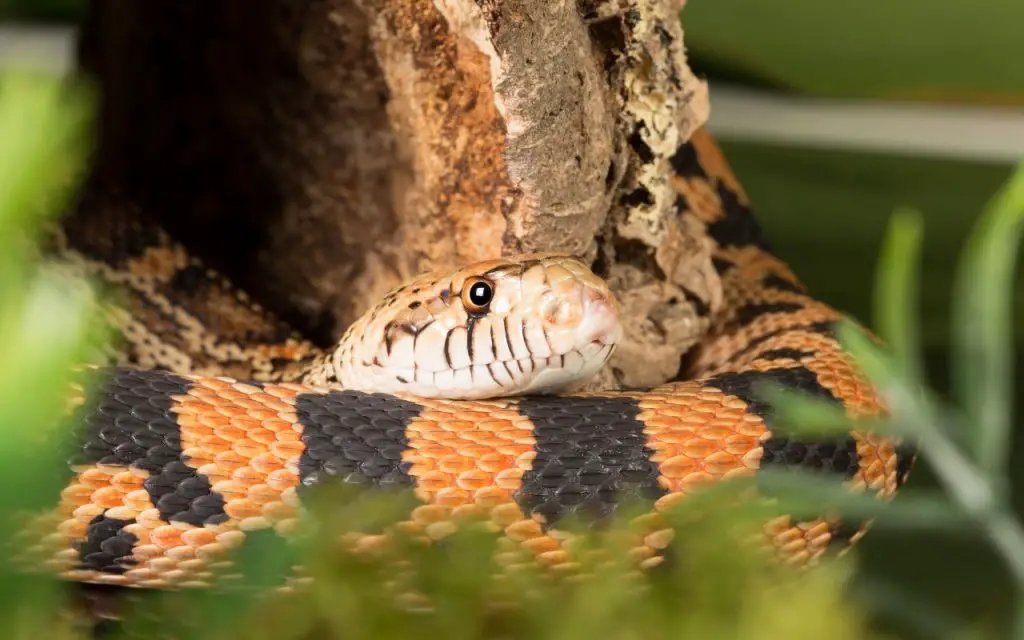
Natural History
Such a tough species! These chunky critters are distributed from north-eastern Mexico to southern Alberta, Canada. Over this range they seem to tolerate wide climate variation but always show a preference for prairie habitat with loose, sandy soil.
This habitat choice is probably due to the fact that loose soil allows them to excavate nests to lay their eggs in. It is also the habitat of choice for their favourite prey which is gophers and ground squirrels. It’s no coincidence they’re called Gopher Snakes after all!
Like most other North American colubrids, they mate in the spring and lay eggs around June (depending on the weather). The eggs are much larger than many other colubrids, however, sometimes up to 4 inches in length (10cm). In ideal conditions, these take around two months to hatch.
During cool weather Bull Snakes are mainly diurnal but become increasingly nocturnal during hot summer months. Similarly, they will spend more time in tortoise or rodent burrows during warm weather.
In some areas they will even go as far as to migrate to different habitats such as forest or wetlands to escape heat, but this isn’t possible across much of their prairie habitat.
Did you know?
The loud hissing that Gopher, Pine and Bull Snakes are famous for is produced using an adaption to their epiglottis.
Part of it is enlarged and forms what is known as an epiglottal keel. This keel obstructs the airstream from the larynx when the snakes are exhaling and hissing. It is thought that the keel vibrates and helps produce their exceptionally loud hissing.
In a nutshell, this is a similar process to blowing on the edge of a sheet of paper. you can learn more about their vocalisations in our post on how Bull Snakes got their name.
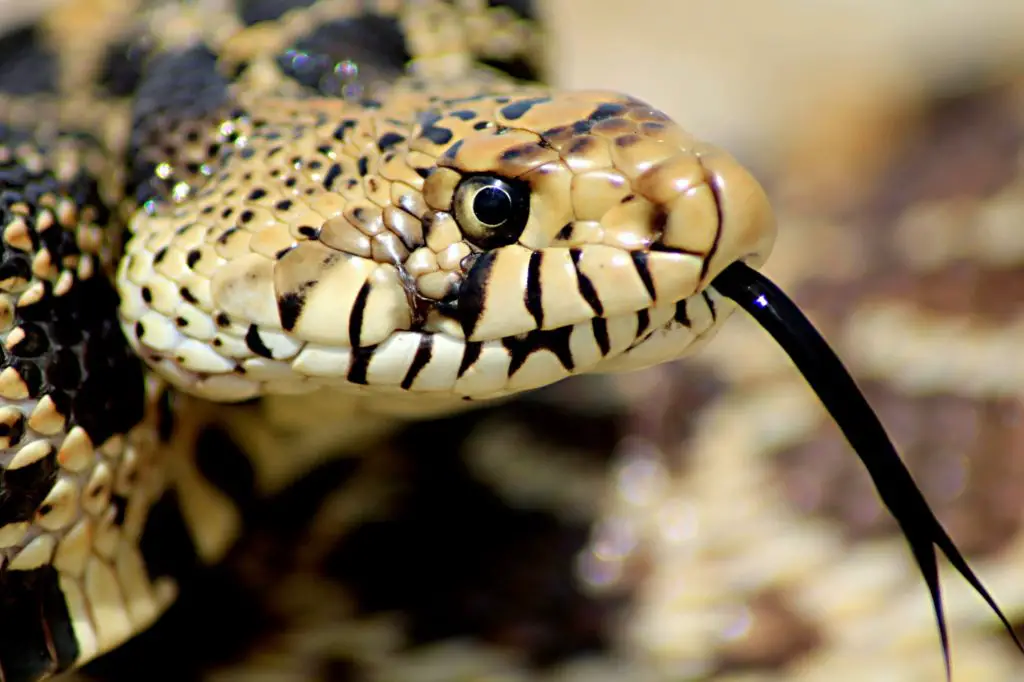
Do Bull Snakes make good pets?
Before getting into their captive care requirements, you obviously need me to answer the above question.
My answer is yes, Bull Snakes make great pets! That said, you need to know three things about them:
- They won’t tolerate excessive humidity.
- They won’t tolerate excessive heat.
- Most of them are bigger and chunkier than Corn Snakes and other popular pet snakes. Having a Bull Snake means having a bigger enclosure and offering bigger meals.
The main thing that I like about Bull Snakes is that they are extremely hardy snakes if you get their temp and humidity right. Moreover, they are not picky feeders, unlike my beloved Ball Pythons.
All in all, if you want a pet that’s a little larger than your average colubrid but still smaller than most pythons and boas then bull snakes are a great choice!

Bull Snake Enclosure
When setting up a Bull Snake enclosure, your main concerns should be good ventilation and a sturdy lid. Make sure that the enclosure has adequate mesh or vents to allow for excellent air circulation.
You can do this in tubs or rack systems just as easily as in vivariums. Before adding ventilation holes it’s worth checking online for prefabricated vents. Some of these work well if glued into the side of tubs, and make controlling humidity much easier.
As with many other species that inhabit semi-arid or plains habitats, humid or stagnant air is bad for Bull Snakes!
The reason I mention a sturdy lid is that Bull Snakes are strong and strong willed. If you don’t have a secure lid on the enclosure, then your snake will almost definitely escape.
Enclosure size
As far as enclosure size goes, I would scale it up from that of a corn snake. This means a tub or faunarium that is at least 12inches (30cm) long for a baby, and a tub or vivarium that is at least 36inches (90cm) long for an average adult.
For the occasional adult that reaches a length greater than 6ft (1.8m) you will need a tub or vivarium that is at least 4ft (1.2m) in length.
Height isn’t too important as bull snakes don’t do much climbing. Also, be aware that they have a destructive streak and will rearrange any furniture or decorations you give them.
For more information on enclosure size, check out the following article: Bull Snake enclosure size.

Hides and water
As with most terrestrial snakes, Bull Snakes need a hide on both the warm and cool side of their enclosure. I recommend using heavy hides like the Exo Terra caves.
For a water bowl, make sure it is sturdy and heavy or they will flip it over. Place their water bowl away from the heat source so that it doesn’t evaporate and cause excessive humidity. Water must be replaced regular for this species, and not less than twice a week.
Substrate
Generally speaking, all Bull, Pine and Gopher Snakes like to have a good burrow and root around from time to time. To this end, you should provide them with a good 2-3inches (5-8cm) of substrate.
Substrates such as cypress mulch and lignocel work well, as does aspen. As always, avoid cedar and pine which are toxic to snakes (yes, even Pine Snake relatives!)
Check out this video of a Bull Snake digging. It seems digging to them is as natural as hiding to a Ball Python!
Temperature and humidity
These are the two main factors you need to get right to keep a Bull Snake healthy.
When it comes to temperatures, make sure they are not too hot! We all know the American south west can get extremely hot, but Bull Snakes avoid this by becoming nocturnal or hiding deep within tortoise or rodent burrows.
As with many other reptiles, these snakes need a thermal gradient to feel comfortable and maintain a healthy immune system.
Daytime temperatures should be 85F (29C) on the warm end and 75F (24C) on the cool end. I recommend a night-time drop to 80F (26C) and 70F (21C) respectively, and this is easy to achieve as long as your house naturally cools down slightly at night.
For heating appliances both heat mats and ceramic heat emitters will work well for this species. Just be sure to use a pulse proportional thermostat to regulate the temperature.
If using a heat mat with a tub or faunarium, the thermostat probe should be stuck between the mat and the underside of the enclosure. If using a heat mat with guard inside a vivarium then tape or glue the probe inside the guard with the mat.
For ceramic heat emitters, place the probe in mid-air on the warm side of the enclosure but not directly under the heat emitter. Always use a guard to cover heat emmiters so that the snake can’t burn itself.
Whichever heating appliance you decide on, keep an eye on the temperature on the inside of the tank by using a digital thermometer probe or infrared thermometer gun.

Make sure the humidity is correct!
With this species you want to aim for an ambient humidity level of 30-40% all year round. This sounds quite low but, they occupy semi-arid areas and plains throughout most of their range.
High humidity can lead to blistering of the ventral scales, scale rot or respiratory infections.
That said, when shedding you can raise the humidity to 50% to help the process or provide a hide box with humid sphagnum moss.
Lighting
As with Ball Pythons, Bull Snakes do perfectly fine without UV lighting. Despite being mostly diurnal, they become nocturnal during the summer months in parts of their range or spend most of their time in rodent burrows.
This means they will be able to synthesise their own vitamin D without the aid of UVB. But just because they don’t need UV light, it doesn’t mean they don’t need any light.
They are diurnal and also brumate in the wild, so adequate light is a must. It allows them to keep their body clock on track and maintain normal cycles of activity.
It doesn’t matter how they get their light. It can be UV or non-UV tube lighting above their enclosure, or a light on in the room – just as long as it’s on for 12hrs a day. All the snakes need is to know whether it’s night or day!
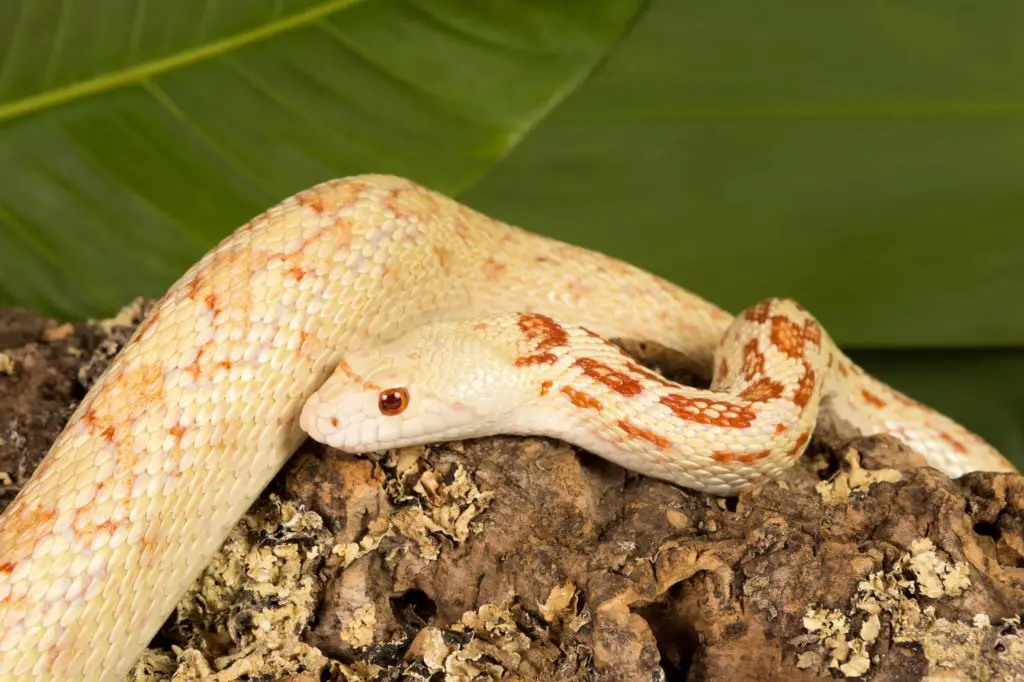
What do Bull Snakes eat?
These guys are rodent specialists, though adults have occasionally been known to eat rabbits and birds in the wild. Apparently, they are also fond of birds’ eggs in some areas, but I have never known anyone to feed them eggs in captivity so can’t comment on this.
Generally speaking, babies will eat a pinkie rat or a hopper mouse every 4-5 days
Adults will eat a mid-sized rat once every 7-14 days.
As with any larger snake, I advise getting them to eat rats at a young age and keeping this as their only food source. Rats have more protein and make one nice, big meal.
After three years in age bull snakes have done most of their growing but tend to keep their voracious appetite. At this point I recommend a weigh in every three months to make sure they aren’t piling on the weight. Obesity is not healthy for them!
Bull Snake Care Summary
| Temperature: | 85F (29C) on the warm end and 75F (24C) on the cool end, drop to 80F (26C) and 70F (21C) at night |
| Humidity: | 30-40%, raising to 50% during shedding |
| Favourite food: | Rats or mice |
| Enclosure size: | 12inches (30cm) long for juveniles, 36inches (90cm) long for average adults, 48inches (120cm) long for large adults |
| Activity rythm: | Mostly diurnal |
| Lighting needs: | UV light not necessary, but ambient lighting beneficial |

How do Bull Snakes compare to other pet snakes?
I’m going to be blunt: I think Bull Snakes are underrated, and mostly undeserving of their grouchy reputation. This is why I’ve added them to my Colubrids category.
All you need to do is invest that little extra time and energy to handle them regularly while growing up and they can be as docile as a Corn Snake.
So, if you like Corn Snakes but want something a bit bigger, Bull Snakes are a great choice.
Just remember that their humidity needs to be correct, and that keeping feeding records and doing three-monthly weigh-ins is advised after their third year of age.
If you follow the above guidelines, these snakes are hardy captives and make GREAT pets!
FAQ relating to Bull Snake Care
Is a bull snake a good beginner snake?
A Bull Snake is a good beginner snake, but not the best beginner snake. They make good beginner snakes because they are very hardy, and seem to do well even we make a few minor husbandry errors along the way. The reason they aren’t one of the best beginner snakes though is that they get quite large and are defensive as juveniles.
What does a bull snake need to survive?
To survive, your pet Bull Snake needs a clean, appropriate enclosure, correct humidity levels, correct temperatures, fresh water and food. All of these parameters are easy to get right and maintain if you read our Bull Snake Care Sheet. The main point to focus on providing a good enclosure and heat source, and the rest will fall into place.
Do bull snakes make good pets?
Bull Snakes make great pets. They’ve long suffered from a bad reputation for aggression, which I feel is undeserved. Many juveniles are nervous and defensive, but with gentle handling they turn into gentle adults. This combined with the fact that they are very easy to care for makes them really good pets.
What size tank do I need for a bull snake?
Bull Snakes vary a lot in size. Some adults never make it to 4 feet long, whereas others get over 6 feet in lenght. In general, you should expect to need at least a three foot enclosure for an adult Bull Snake. If it outgrows this, then you will need a 4×2 x2ft enclosure.
